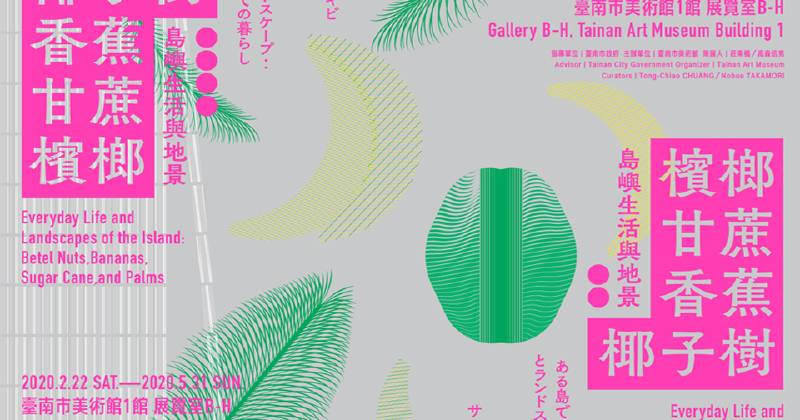臺南市立美術館
【島嶼生活與地景檳榔、香蕉、甘蔗、椰子樹】

-
展期
日期:2020-02-22 ~ 2020-05-31
-
地點
台南市中西區南門路37號(1館2樓展覽室B、1館2樓展覽室C、1館2樓展覽室D、1館2樓展覽室E、1館2樓展覽室F、1館2樓展覽室G、1館2樓展覽室H)
-
參展藝術家
伊誕.巴瓦瓦隆、李俊賢、李若玫、林書楷、約翰.湯姆生、倪再沁、峨冷.魯魯安、張新丕、曹淳、許淑真+盧建銘、陳建成、陳穎亭、黃金樹、黃庭輔、鈴木貴彥、劉致宏、謝牧岐、羅懿君
-
在一個日常的觀展經驗之中,艱澀的抽象表現及當代概念或許較難為民眾所認知,但當畫面之中出現了民眾所熟悉的植物或果物之時,不免會發現民眾常常熱衷地討論了起來。因為當討論檳榔、甘蔗、香蕉及椰子樹等植物時,這並非陌生且異國的植物學標本,這是和多數島嶼居民生活經驗所切身相關的生活地景、飲食文化及產業系統。若說這些作品及本展意欲喚醒些什麼,可能是重新嘗試尋找臺灣現當代藝術與臺灣生活經驗的直接聯繫,亦可能是藉此反推,理解臺灣藝術家在此脈絡中所扮演的角色。
日治時期,詩人西川滿常以「華麗島」(Karei-Tō)一詞來形容臺灣的地景。戰後不論是國府轉進來臺常用的「寶島」,還是戒嚴時期的黨外運動中具有號召力的「美麗島」語彙,其實都在指涉同一件事情:臺灣是座美麗、且充滿寶藏的島嶼。不論是殖民者、統治者、還是草根庶民,大家皆用不同的立場投射自己對於島嶼的想像。而最直接承載這些想像的意象,除了臺灣島在地圖上彷如番薯一般的島嶼形狀外,便是遍布島嶼上的熱帶作物。檳榔作為臺灣南島文明中少數仍可傳承至漢人移民社會之中的作物,於現代化的過程中遭遇程度不等的歧視。蔗糖及香蕉則是因為殖民地的經濟建設被廣泛栽培,相關的產業鏈亦塑造了臺灣的產業地景。椰子樹出於殖民者追求的異國風情觀賞目的,成為了臺灣都市地景的核心。
本展嘗試展出不同時代的作品及藝術家,透過這些創作來針對上述的四種作物進行探討。當19世紀末蘇格蘭探險家約翰.湯姆生(John Thomson)首次來訪臺灣並拍攝下島嶼的地景時,當時島嶼還維持著自然的林相。但隨著殖民及現代化,糖廠、香蕉園及檳榔園構成了臺灣鄉村的尋常地景,而椰子樹蔭及移民社會則成為了臺灣都市的日常風景。正因為檳榔、香蕉、椰子樹是臺灣的尋常地景,而甘蔗是戰後其中唯一的公營農業加工販售產業,蔗田與糖廠曾是多數人童年記憶裡的風景,因此它們才會如此深刻的烙印在我們的生活中;當我們嘗試描述它們時,我們所描述的不僅是自然地景,而是臺灣人的記憶、生命經驗及歷史意識。
Abstract expressions and contemporary concepts presented in exhibitions are perhaps sometimes difficult for people to grasp fully; however, when they see images of familiar plants or fruits, it is more likely for them to engage in enthusiastic discussions. Betel nut, sugarcane, banana, and palm tree are closely connected to this island’s daily landscape, culinary culture, and industrial system; to the dwellers of this item, these are familiar plants and not strange and exotic botanical specimens. What the artworks on view in this exhibition seek to highlight is a way to rediscover the direct connections between modern and contemporary Taiwanese art and everyday experiences in Taiwan. Furthermore, an attempt is also made to understand the role of Taiwanese artists within this context.
During the Japanese colonial period in Taiwan, poet Mitsuru Nishikawa often referred to Taiwan as Karei-Tō, or beautiful island. After the war, the Nationalist government that retreated to Taiwan often called the island, Baodao, or treasure island. The term, Formosa, which also means beautiful island, was used as an inviting and appealing name by those in the Tangwai Movement when Taiwan was still under martial law (tangwai literally means “outside of the party”). All of these names share one thing in common, which is that Taiwan is a beautiful island full of treasures. Colonizers, rulers, or common everyday people have projected their imagination of the island through the various perspectives that they hold. In addition to the yam-shaped island that we see on maps, the most direct imageries that embody all of these imaginations of Taiwan are the tropical plants that are seen throughout the island. Betel nut is one of the rare crops that has been passed down from Taiwan’s Austronesian culture to its Han Chinese migrant society. It has also been discriminated at various levels throughout the process of modernization. Sugarcane and banana were also prevalently planted in the colonial period to boost economic development, and the industry link formed based on these crops had come to shape the industrial landscape of Taiwan. Palm trees were introduced by the colonial regime for the exotic viewing pleasures that the plant provides, which had, subsequently, become a central element of Taiwan’s urban landscape.
The objective of this exhibition is to examine the aforementioned four plants through artworks by artists from various periods in time. The photographs taken by Scottish explorer John Thomson when he travelled to Taiwan for the first time at the end of the 19th century show the island of Taiwan in a very natural state. With subsequent colonization and modernization, sugar plants, banana and betel nut groves became common scenes in Taiwan’s rural areas, and palms and migrant society formed the common urban landscape seen in Taiwanese cities. Betelnut, banana, palm were once ubiquitous in Taiwan, and sugarcane was the only agricultural product that was processed and sold by the government after the war; therefore, sugarcane fields and sugar refineries played a memorable part in many Taiwanese people’s childhood. Because of these reasons, these things are deeply imprinted in Taiwanese people’s lives. When we try to describe them, we are not just describing natural landscapes; they are a part of Taiwanese people’s memories, experiences in life, and also historical consciousness.
推薦展覽
view all帝門藝術中心
【影響世界的紐約明星藝術家們】Roland Hagenberg Photo Portraits from the 80s in New York
日期:2022-12-03 ~ 2023-01-10|台灣,台北市
